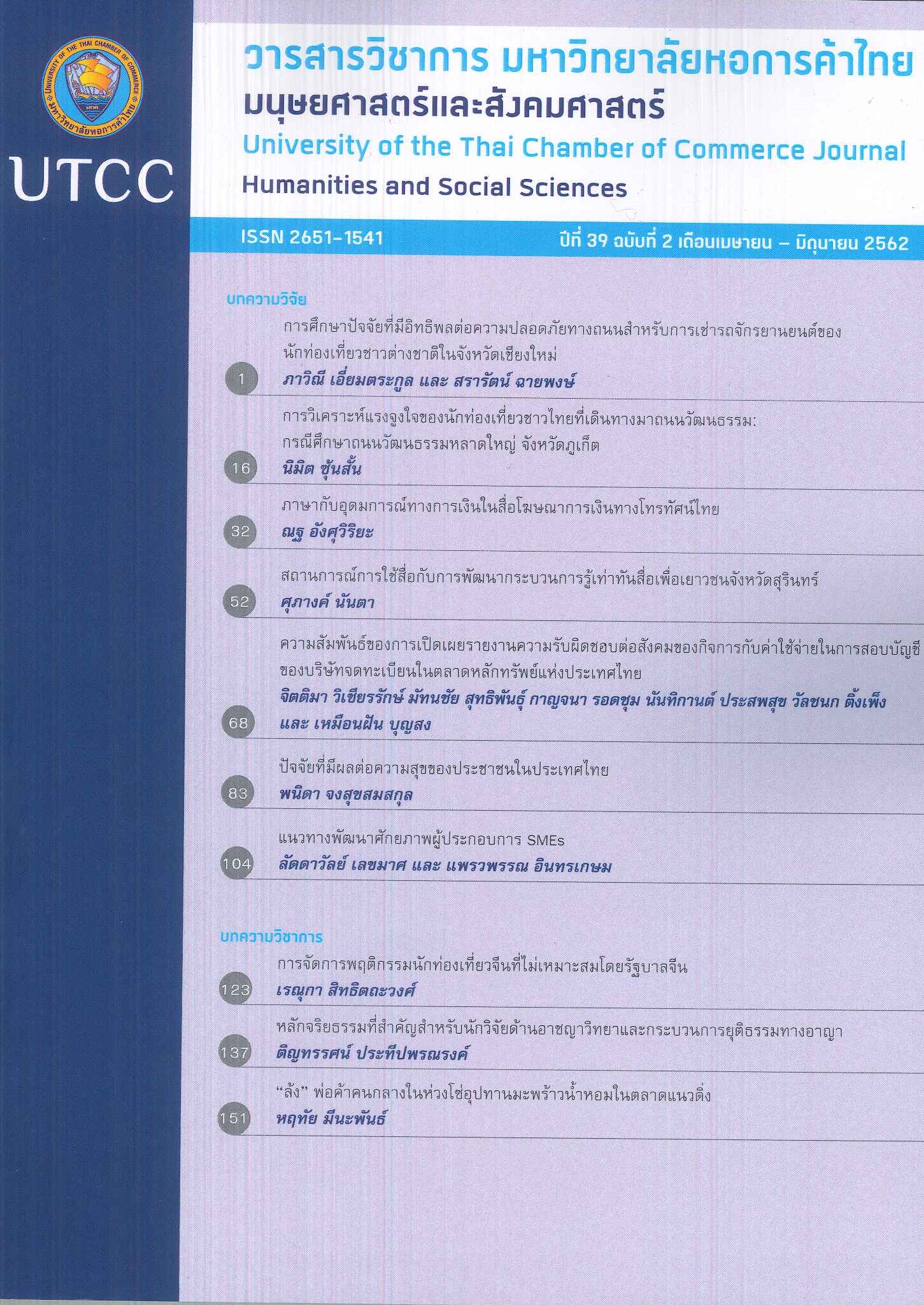Managing Inappropriate Behavior of Chinese Tourists by Chinese Government
Main Article Content
Abstract
This article aims to mention about the inappropriate behavior of Chinese tourists in other countries and the analysis of behavior’s causes. It also explains the Chinese tourist behavior management methods by the Chinese government, which issued “Guidelines of the Civilized Tourism and Travel Abroad” to guide the behavior of Chinese tourists and issued “The governance measure regarding the management of transient records for the behavior of non-civilized Chinese tourists" to record the names of Chinese tourists who behaved improperly during their travels. Finally, it assessed the effectiveness of the Chinese government and included comments and suggestions.
Article Details
ลิขสิทธิ์ของบทความ
ผลงานที่ได้รับการตีพิมพ์ถือเป็นลิขสิทธิ์ของมหาวิทยาลัยหอการค้าไทย ห้ามมิให้นำเนื้อหา ทัศนะ หรือข้อคิดเห็นใด ๆ ของผลงานไปทำซ้ำ ดัดแปลง หรือเผยแพร่ ไม่ว่าทั้งหมดหรือบางส่วนโดยไม่ได้รับอนุญาตเป็นลายลักษณ์อักษรจากมหาวิทยาลัยหอการค้าไทยก่อน
References
คลิปว่อน! นักเที่ยวจีนโชว์ถ่อย ยกเท้าถีบระฆังวัดพระธาตุดอยสุเทพ. (2558, 22 กุมภาพันธ์). MGR Online. สืบค้นจาก https://mgronline.com/local/detail/9580000021365
ยายเชื่อโชคลางโยนเหรียญใส่เครื่องยนต์เครื่องบินโดยสาร. (2560, 28 มิถุนายน). BBC News ไทย. สืบค้นจาก https://www.bbc.com/thai/international-40427127
42 times tourists were caught behaving badly. (2017, July 8). South China Morning Post. Retrieved from http://www.scmp.com/news/china/article/1663135/they-behaved-barbarians-chinese-state-media-blasts-tourists-who-scalded
China National Tourism Administration. (2017). China tourism: 2016 statistics and 2017 economic predictions. Retrieved 2018, February 5, from http://en.cnta.gov.cn/Statistics/TourismStatistics/201710/t20171013_842558.shtml
China National Tourism Administration. (2018). The list of uncivilized travel behavior of Chinese tourists. Retrieved 2018, February 8, from www.cnta.gov.cn/zdzx/zszt/201 507/t20150702_720026.shtml
Feeding frenzy: Internet users aghast at video of Chinese tourists shoveling shrimp at buffet in Thailand. (2016, March 21). South China Morning Post. Retrieved from http://www.scmp.com/news/china/society/article/1927681/feeding-frenzy-internet-users-aghast-video-chinese-tourists
Tourists behaving badly: Name-and-shame effort fails to fix China’s image. (2016, October 10). The New York Times. Retrieved from https://www.nytimes.com/2016/10/11/world/asia/bad-manners-china-tourism-blacklist.html
中国国民共和国国家旅游局.(2016). 文明旅游出行指南. 游览于2018年2月5日,从http://file.ahta.com.cn/part/131009150539_1.pdf
中国国民共和国国家旅游局.(2018). 旅游不文明行为记录. 游览于2018年2月8日,从 www.cnta.gov.cn/zdzx/zszt/201507/t20150702_720026.shtml
中国国民共和国国家旅游局. (2016).国家旅游局关于旅游不文明行为记录管理暂行办法. 游览于2018年2月7日,从www.cnta.gov.cn/zwgk/tzggnew/20 1605/t20160530_772536.
李俐. (2013). 黄渤帕劳潜水捞到“中华”烟盒 称丢不起脸,游览于2018年2月9日,从 http://travel.sina.com.cn/world/2013-02-25/1115191437.shtml
王雨慈. (2016). 国旅游者不文明旅游行为的原因及对策研究. 城市规划
夏德元. (2013). “到此一游”的传播学解读与应对之道新闻界. 新闻界
薛菲,郑永贤. (2017). 旅游不文明行为归因分析——中西文化比较视角.江苏商
张力. (2017). 全面开启新时代教育现代化新征程. 云南教育(视界综合版)


